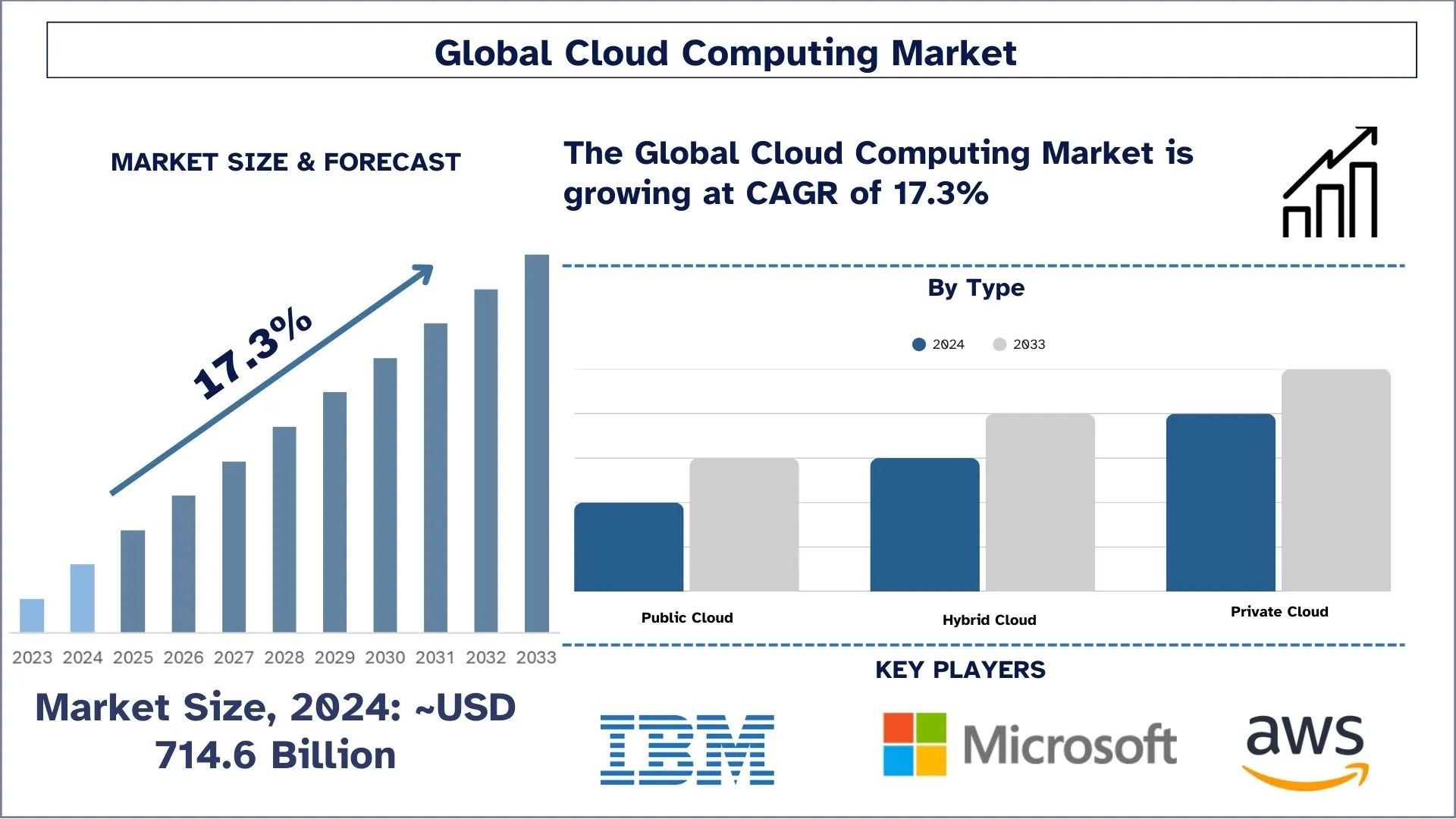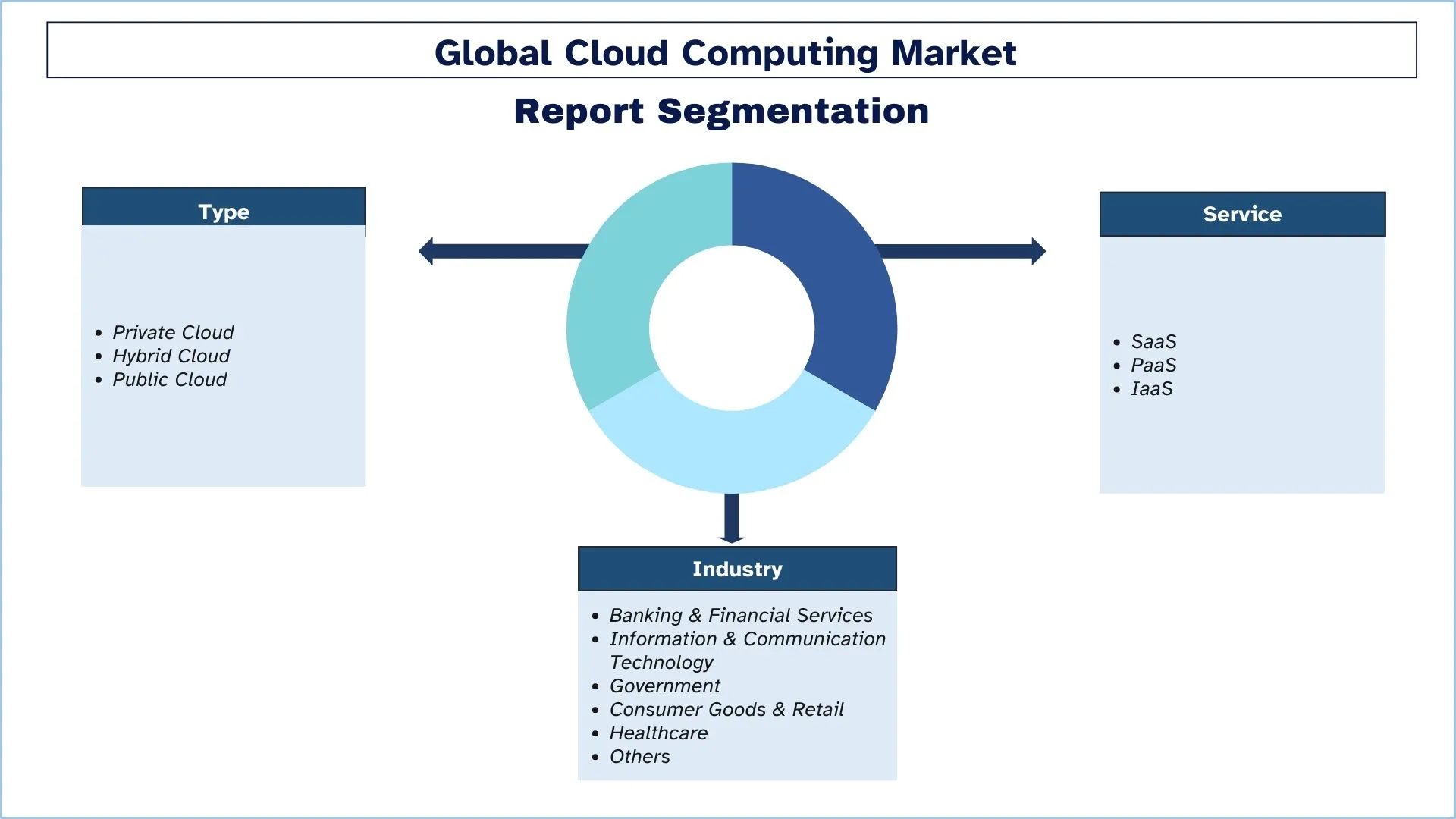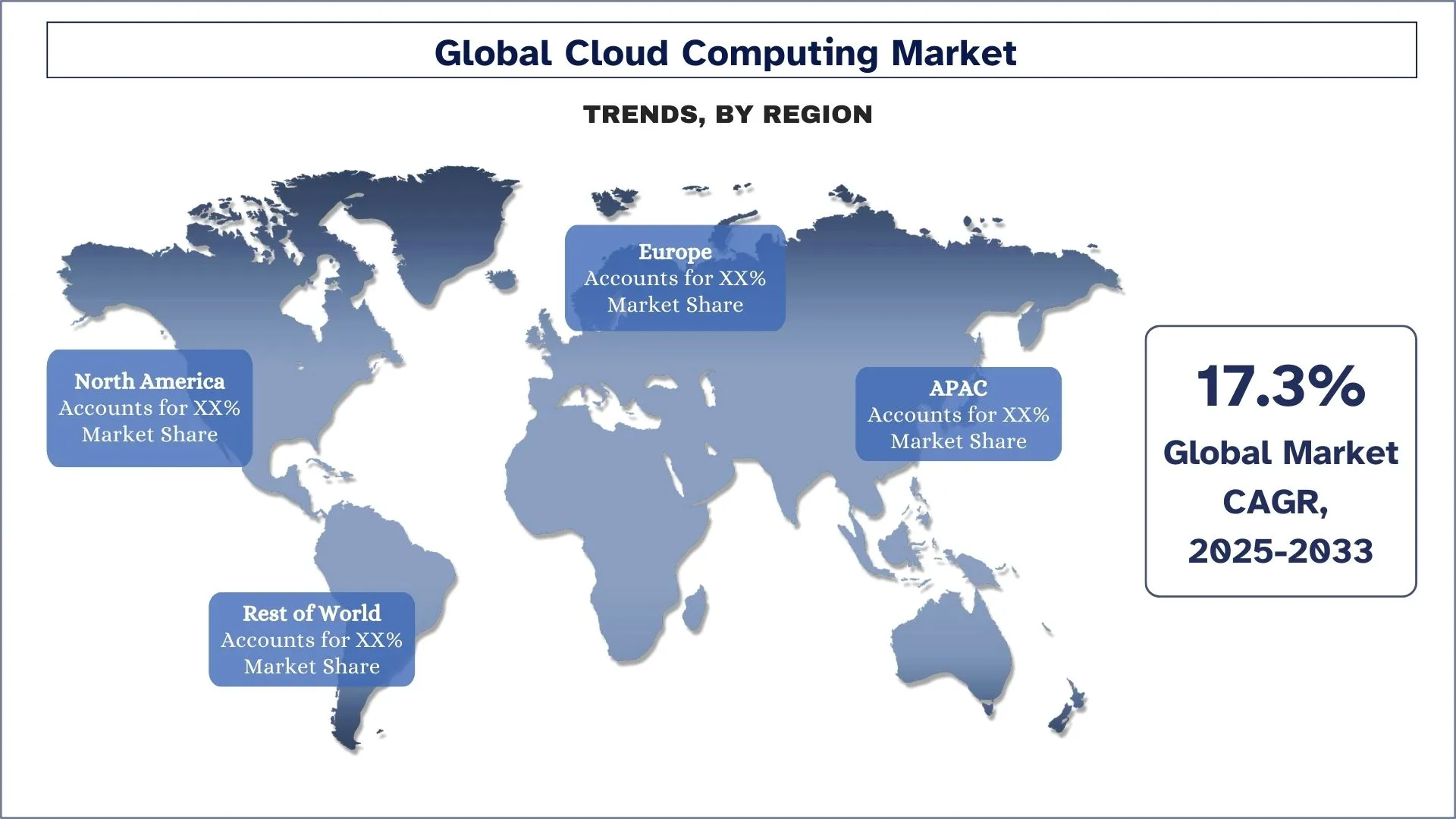- Home
- About Us
- Industry
- Services
- Reading
- Contact Us
Cloud Computing Market: Current Analysis and Forecast (2025-2033)
Emphasis on Type (Private Cloud, Hybrid Cloud, Public Cloud); Service (SaaS, PaaS, IaaS); Industry (Banking and Financial Services, Information and Communication Technology, Government, Consumer Goods and Retail, Healthcare, and Others); and Region and Country

Cloud Computing Market Size & Forecast
The Cloud Computing Market was valued at approximately USD 714.6 billion in 2024 and is expected to grow at a substantial CAGR of around 17.3% during the forecast period (2025-2033), owing to the rising demand for remote work solutions and digital transformation.
Cloud Computing Market Analysis
Key factors influencing the growth of the cloud computing market are the increasing adoption of AI and big data technologies, the need for massive data storage requirements, and organizational agility & flexibility. With the increasing demand for data security, the cost of computation devices, and massive and steadily increasing data storage requirements, the demand for cloud computing is increasing. The world generated 64.2 zettabytes of data in 2020, and this number is expected to rise by producing 181 zettabytes of data in 2025. All this data needs to be stored somewhere; however, it is extremely costly and insecure to store data in physical data storage devices. Cloud computing provides cloud storage that is cheaper and easier to manage than storage devices. Security walls in cloud storage are extremely difficult to penetrate by hackers, hence, the chances of data loss are extremely low. Thus, creating tremendous opportunities for players offering cloud computing services.
Cloud Computing Market Trends
This section discusses the key market trends influencing the various segments of the Cloud Computing market as identified by our research experts.
Rapid adoption of multi-cloud and hybrid cloud strategies
The primary trend currently being witnessed within the cloud computing environment is the shift towards using multiple and hybrid clouds. Business continuity across several organizations is now putting their workload across several clouds such as AWS, Azure, and Google Cloud while incorporating private cloud as well as On-premises. This reduces vendor lock-ins, increases system availability and resilience, while making it possible for businesses to harness the strengths of various platforms. Furthermore, such configurations help optimize costs, control data, and meet regional regulations, which makes hybrid architectures a good solution for handling various types of workloads and security standards within the same enterprise.
Cloud Computing Market Industry Segmentation
This section provides an analysis of the key trends in each segment of the global Cloud Computing market report, along with forecasts at the global, regional, and country levels for 2025-2033.
The Private Cloud Segment is Expected to Witness a Higher CAGR than the Cloud Computing Market.
Based on type, the market is segmented into public cloud, private cloud, and hybrid cloud. Among them, the private cloud accounted for a significant share of the global cloud computing market. The private cloud (also known as the internal or corporate cloud) is a cloud computing environment in which all hardware and software resources are dedicated exclusively to, and accessible only by, a single user organization. The private cloud provides a high level of data security and privacy through firewalls and internal hosting.
The SaaS Segment Holds the Largest Share of the Market.
Based on service, the market is categorized into SaaS, PaaS, and IaaS. Among these, SaaS held a prominent revenue share of the overall cloud computing market in 2024 and is expected to witness strong growth during the forecast period. Cost-effectiveness, flexibility, data security, and scalability are some of the most prominent factors driving the category’s growth. Furthermore, SaaS is a way of delivering applications over the internet as a service, Organizations can access the application through the internet. SaaS releases organizations from complex software and hardware management.

North America has a significant share of the market in 2024.
North America dominated the global cloud computing market in 2024. This can be attributed to the strong emphasis on digital transformation and the trend of being adopters of next-generation technologies. Many businesses in North America are making a transition or have completely transitioned toward the hybrid work model. Moreover, numerous vendors such as Microsoft Corporation, Oracle Corporation, Amazon.com Inc., and International Business Machines Corporation, and the high propensity to adopt new technologies are expected to drive the growth of the cloud computing market in this region.
U.S. Dominates the North American Cloud Computing Market
The US cloud computing market is growing steadily with the support of the digitization process, AI, and new working models such as remote and hybrid working. Cloud service is, therefore, gaining momentum in different sectors to enhance the flow of business, information storage, and flexibility. SaaS is currently the most adopted type of cloud computing, and IaaS is rapidly gaining popularity due to the need for flexible computing. AWS, Microsoft Azure, and Google Cloud remain market leaders but are still open to providing solutions for different scales of companies. The United States continues to be the world’s leader in terms of cloud development and cloud usage among enterprises.

Cloud Computing Market Industry Competitive Landscape
The Cloud Computing market is competitive, with several global and international players. The key players are adopting different growth strategies to enhance their market presence, such as partnerships, agreements, collaborations, new product launches, geographical expansions, and mergers and acquisitions.
Top Cloud Computing Market Companies
Some of the major players operating in the market are Amazon Web Services, Inc.; Microsoft Corporation; Google LLC; IBM; Oracle Corporation; VMware Inc.; Salesforce Inc.; Alibaba Group Holding Limited; Hewlett-Packard Enterprise; and SAP SE
Recent Developments in the Cloud Computing Market
In January 2024, American Tower and IBM joined forces to Empower Businesses with Cutting-Edge Cloud Solutions. This collaboration aims to revolutionize how businesses approach innovation and customer experiences. American Tower will integrate IBM's hybrid cloud technology and Red Hat OpenShift into its existing Access Edge Data Center network. This combined offering will provide enterprises with powerful tools to leverage the potential of technologies like IoT, 5G, AI, and network automation. By working together, American Tower and IBM will empower businesses to meet the ever-evolving demands of their customers in the age of digital transformation.
In January 2024, Eviden and Microsoft signed a five-year strategic partnership. This collaboration expands on their existing relationship by bringing innovative Microsoft Cloud and AI solutions to diverse industries, which aligns with Eviden's broader alliance strategy of solidifying existing partnerships and building new ones to strengthen its global network.
Cloud Computing Market Report Coverage
Report Attrbute | Details |
Base year | 2024 |
Forecast period | 2025-2033 |
Growth momentum | Accelerate at a CAGR of 17.3% |
Market size 2024 | USD 714.6 Billion |
Regional analysis | APAC, Europe, Asia-Pacific, Rest of the World |
Major contributing region | North America is expected to grow at the highest CAGR during the forecasted period. |
Key countries covered | U.S., Canada, Germany, France, UK, Spain, Italy, China, Japan, and India |
Amazon Web Services, Inc.; Microsoft Corporation; Google LLC; IBM; Oracle Corporation; VMware Inc.; Salesforce Inc.; Alibaba Group Holding Limited; Hewlett-Packard Enterprise; and SAP SE | |
Report Scope | Market Trends, Drivers, and Restraints; Revenue Estimation and Forecast; Segmentation Analysis; Demand and Supply Side Analysis; Competitive Landscape; Company Profiling |
Segments Covered | By Type, By Service, By Industry, By Region/Country |
Reasons to Buy the Cloud Computing Market Report:
The study includes market sizing and forecasting analysis validated by authenticated key industry experts.
The report presents a quick review of overall industry performance at a glance.
The report covers an in-depth analysis of prominent industry peers with a primary focus on key business financials, product portfolios, expansion strategies, and recent developments.
Detailed examination of drivers, restraints, key trends, and opportunities prevailing in the industry.
The study comprehensively covers the market across different segments.
Deep dive regional-level analysis of the industry.
Customization Options:
The global cloud computing market can be customized further as per the requirements or any other market segment. Besides this, UnivDatos understands that you may have your own business needs; hence, feel free to contact us to get a report that completely suits your requirements.
Table of Content
Research Methodology for Cloud Computing Market Analysis (2023-2033)
We analyzed the historical market, estimated the current market, and forecasted the future market of the global Cloud Computing Market to assess its application in major regions worldwide. We conducted exhaustive secondary research to gather historical market data and estimate the current market size. To validate these insights, we carefully reviewed numerous findings and assumptions. Additionally, we conducted in-depth primary interviews with industry experts across the Cloud Computing Market value chain. After validating market figures through these interviews, we used top-down and bottom-up approaches to forecast the overall market size. We then employed market breakdown and data triangulation methods to estimate and analyze the market size of industry segments and sub-segments.
Market Engineering
We employed data triangulation techniques to finalize the overall market estimation and derive precise statistical numbers for each segment and sub-segment of the global Cloud Computing Market. We split the data into several segments and sub-segments by analyzing various parameters and trends, including type, service, industry, and regions within the global Cloud Computing Market.
The main objective of the Global Cloud Computing Market Study
The study identifies current and future trends in the global Cloud Computing Market, providing strategic insights for investors. It highlights regional market attractiveness, enabling industry participants to tap into untapped markets and gain a first-mover advantage. Other quantitative goals of the studies include:
- Market Size Analysis: Assess the current and forecast market size of the global Cloud Computing Market and its segments in terms of value (USD).
- Cloud Computing Market Segmentation: The study segments the market by type, service, industry, and region.
- Regulatory Framework & Value Chain Analysis: Examine the regulatory framework, value chain, customer behavior, and competitive landscape of the Cloud Computing Market industry.
- Regional Analysis: Conduct a detailed regional analysis for key areas such as Asia Pacific, Europe, North America, and the Rest of the World.
- Company Profiles & Growth Strategies: Company profiles of the Cloud Computing Market and the growth strategies adopted by the market leaders to sustain the fast-growing market.
Frequently Asked Questions FAQs
Q1: What is the Cloud Computing market's current size and growth potential?
As of 2024, the global cloud computing market is valued at approximately USD 714.6 billion and is projected to grow at a CAGR of 17.3% through 2033.
Q2: What are the driving factors for the growth of the Cloud Computing market?
Rising demand for remote work solutions and digital transformation is pushing organizations toward scalable and flexible cloud services.
Q3: Which market has the largest share of the Cloud Computing market by component type?
The platform category dominates the global Cloud Computing market by component type segment.
Q4: What are the major trends in the Cloud Computing market?
The growing adoption of multi-cloud and hybrid cloud strategies is enabling businesses to optimize performance, avoid vendor lock-in, and improve resilience.
Q5: Which region will dominate the Cloud Computing market?
The North America region currently dominates the global Cloud Computing market.
Q6: What are the biggest challenges in the Cloud Computing market?
Data privacy and security remain major concerns, especially with increasing regulatory requirements and cross-border data flow issues.
Q7: Who are the Top players in the global Cloud Computing market?
The leading companies driving innovation in the Cloud Computing market include:
• Amazon Web Services, Inc.
• Microsoft Corporation
• Google LLC
• IBM
• Oracle Corporation
• VMware Inc.
• Salesforce Inc.
• Alibaba Group Holding Limited
• Hewlett-Packard Enterprise
• SAP SE
Q8: How is hybrid cloud architecture benefiting organizations?
Hybrid cloud allows businesses to combine on-premises infrastructure with public and private cloud environments, offering greater flexibility, cost control, and improved data management.
Q9: How is edge computing related to cloud computing?
Edge computing complements cloud computing by processing data closer to the source (like IoT devices), reducing latency and bandwidth usage, while the cloud handles large-scale storage and advanced analytics.
Related Reports
Customers who bought this item also bought










